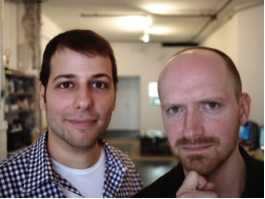Jonathan Dorfman & Szymon Weglarski | CG Animators
![]()
Jonathan Dorfman and Szymon Weglarski
(both B.F.A. Computer Graphics and Interactive Media ’02)

Jonathan Dorfman and Szymon Weglarski, both Pratt Institute B.F.A. graduates in Computer Graphics and Interactive Media, launched their digital animation/VFX company, HiFi 3D, in 2010 to provide high-end animation production services for a variety of media, from commercials to feature films. The partners won a 2012 Emmy for “Outstanding Special Visual Effects” for their work on the HBO show Boardwalk Empire. The Emmy-winning sequence appeared in the episode “Georgia Peaches,” (Season 2, Episode 10). It involved a waterfront scene where contraband is being unloaded from a cargo ship. The challenge was that there was no ship. Dorfman and Weglarski were responsible for creating a period-accurate, photorealistic freighter that was completely computer generated.
How long have you been working together?
SW: Officially we started our company in 2010, but we have always been doing something together since
college. Our company has grown organically into what it is.
JD: We met in 1998, in our freshman 3-D class, and have been great friends ever since. After we left
Pratt we were both freelancing doing computer graphics, commercial animation, and occasionally working
together. In our spare time, we collaborated on a self-funded film project, a sci-fi comedy about killer
gingerbread men called Gingerbreed. We wrote, shot, and directed it with live actors interacting with
digital characters and backgrounds. While still working as freelance computer graphics artists, we would
take summers off to work on the film, slowly building our own animation studio. We’re still working on the
film. We use it as a testbed for learning new visual effects techniques. Once we’ve ironed out the kinks in
a new technique, we feel comfortable applying it in our commercial projects.
How did the Boardwalk Empire project come along?
JD: Our company was approached by Brainstorm Digital in Dumbo to provide 3-D elements for them to
integrate into some of the more difficult shots in the show. They are extremely talented, and we really
enjoyed working with them.
How did the Emmy nomination come about?
SW: Brainstorm Digital called us to tell us that the team had been nominated. Ultimately we shared the
Emmy with them and several others. Many companies work for companies who work for companies. The
industry is surprisingly layered.
SW: My name wasn’t on the nomination, but there was a logic to that. Earlier this year, Boardwalk was
nominated for an award from the Visual Effects Society. We were given the opportunity to put forward just
one of our names, so we put mine. We were thrilled to end up winning the Visual Effects Society award.
JD: A few months later, we were thrilled again to be nominated for the Emmy. This time, my name was
included, so we were both able to go on stage and accept the award at the ceremony.
Where are you keeping your Emmy?
JD: We are keeping it at our studio, on a new shelf that we built for awards, next to our Visual Effects
Society award.
What other projects are you particularly proud of?
SW: One of the first projects we did as a company was an over-the-top intro for an Alaskan hockey team,
the Nanooks. The intro from the previous year had gone viral for being so unintentionally hilarious, and
we jumped at the chance to work on the sequel.
JD: People responded really well to our version, and it was featured on G4’s “Attack of the Show,
CollegeHumor” on the Sports Show with Norm Macdonald, and has over a million views on YouTube.
My favorite part is that they play it on the jumbotron at the stadium in Alaska whenever the team comes
out.
SW: Sometimes it’s fun to work on a project that’s so exaggerated and loose, but on the other end of the
spectrum, it’s also nice when you get to work on something subtle and refined, like the Wild Ducks
project we did for IBM.
JD: Davis Guggenheim was directing a documentary for the IBM Centennial, which included several
animated sequences. They were looking for a painterly style, and we worked with a fantastic designer
called Pistachios to nail the watercolor effects.
What do you think are some of the misconceptions about the computer graphics
industry?
SW: People don’t realize how many artists are involved in bringing the work to life. Creativity happens at
different points in the process, and in different ways. For example, I worked on many of the GEICO
Gecko commercials when I worked at Framestore, but I didn’t come up with the Gecko itself.
JD: I think it’s more of an assembly line than people realize. It’s rare for one individual to take a project
from concept to final.
SW: If you’re looking to create your own content and maintain creative control, you need to be disciplined
and find time to do your own work.
JD: Having our own company lets us participate in the industry on our terms, while giving us the ability to
develop our own projects as well.
Interview: Bay Brown
Photo: Michael Sime
Originally published in Gateway Newsletter